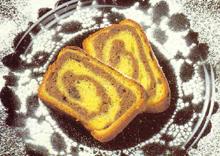By Cat, Nov 2007 (Photo, right, from Wikimedia Commons)
See also: 1. Wheat (about); 2. Bread Basics (Yeast-Leavened Breads); 3. Basic Yeast Bread; 4. Bread & Rolls Menu
This sponge-method recipe is adapted from the original Tassajara Rich Yeast Bread recipe that uses a sponge (1); also Basic Roll Dough and Richer Roll Dough recipes from Home Baking Made Easy, which do not use a sponge (2). Refer also to my Basic Yeast Bread for tips and more detail. I prefer to use an overnight sponge rest.
This recipe produces a richer bread than the regular Yeast Bread recipes, because of the addition of egg(s) and more butter. It has a shorter rise time than the regular yeast bread, and does not need the second rising before shaping, although you may include that. It makes only 1 loaf, or about 15 – 18 rolls.
This rich dough is suitable for the following sweet rolls/breads (this is just a sampling):
- Cinnamon Rolls,
- Pull-Apart Carmel Rolls
- Kolaches
- Norwegian Coffee Cake (Kringle)
- Swedish Tea Ring
- Nut Rolls
- Fruit-Filled Breads
- Braided Christmas Bread
[Originally (as on my old site) I used yogurt with the milk to provide an acidic medium for breaking down the phytates. (refer to Basic Yeast Bread, Pre-soak Sponge Method for more on this). I have since concluded that the acidic pre-soak does not work so well for yeast-risen breads, so I have removed the yogurt presoak from the recipe.]
Rich Yeast Bread, Sponge Method
This recipe is adapted from the original Tassajara Yeast Breakfast Bread recipe. I prefer to use milk rather than water plus dry milk. The Tassajara recipe includes the egg in the sponge, but I prefer to add it in part 2.
It’s best to use whole grain hard wheat for the sponge; Kamut and spelt are more comparable to soft wheat, which is a lower protein bread and may not rise as well as hard wheat. If you wish, you can use other grains (such as barley or oat flour, rolled oat, cornmeal, or millet) for the whole grain flour in part 2. Be aware that this can affect the amount of white flour needed.
My preference for all the flour in this recipe is Wheat Montana Prairie Gold (Hard White whole wheat) flour. (refer to my article on Flour for more info).
This makes 1 standard sized loaf, or 15 – 18 rolls.
Ingredients & Equipment:
Equipment:
- glass measuring cup
- large bread bowl
- heavy duty wooden spoon
- stand mixer fitted with dough hook (optional)
- board for kneading
- cotton dish towel (for covering the bowl)
Part 1, the sponge:
- ¼ cup lukewarm water (110°F)
- 2 Tbsp Rapadura sugar
- 1 ½ Tbsp dry yeast (1 ½ packages)
- ¾ cup fresh milk, scalded (if using pasteurized milk, scalding is optional)
- 1 ½ cups whole grain hard wheat flour (I use Wheat Montana’s Prairie Gold)
- Scald milk, then let it cool to point where you cannot feel its warmth on the the back of your wrist (about 100° – 105°F).
- Proof yeast in warm water mixed with about 1 tsp of the sugar. When scalded milk has cooled enough, add it to yeast in mixing bowl, then add remaining sugar.
- Stir in whole grain flour, working it for 100 strokes.
- Let rest overnight, covered with damp cloth and placed in a plastic bag to keep moist. Ideal resting temperature is 65° – 70°F)
Part 2:
- 2 ½ – 3 Tbsp real butter
- 1 ¼ Unrefined sea salt
- 1 egg, lightly beaten to blend
- ½ cup additional whole wheat flour *
- 1 ¼ – 1 ½ cup unbleached white flour *
* Or 1 ½ – 2 cups unbleached white flour and eliminate whole wheat flour.
- Mix dough: Fold salt and butter, then egg into sponge. Using your floured hand, fold* in ½ cup whole wheat flour, then add white flour, ¼ cup at a time until the dough separates from the sides of the bowl. Let rest about 10 minutes, then turn out onto floured board (using white flour).
- Knead 5 – 10 minutes until smooth and elastic; it will still be a little soft.
- First rise about 50 – 60 minutes, until doubled in bulk (2-finger test; see Bread Basics (Yeast-Leavened Breads).
- Second rise (optional): Punch down in several places to deflate. Cover again and rise about 40 – 50 minutes, until doubled in bulk.
- Shape into loaf or rolls. Rise again about 25 minutes while oven is preheating (350° – 375°F). Brush on egg wash (if using).
* When mixing in the flour in part 2, it is important to fold the dough, rather than cutting through the dough with a stirring implement. This is best done with a floured hand, cupping and turning the dough with love. Above all, avoid tearing or cutting the dough, as this disturbs the gluten and will negatively impact the rise of the dough, and the texture of the resulting bread.
Bake:
1. Bake in preheated oven, using the following times as a guide:
- Individual rolls: about 15-30 minutes depending on size of rolls & oven temperature;
- Braids or wreaths about 30 -50 minutes;
- Full-size loaf: about 1 hour.
2. Remove from oven and cool on rack. Optional: brush with butter while still warm.
Testing
I’ve made this many times, long before starting this blog, but I’ve not made it recently.
References
- The Tassajara Bread Book, but Edward Epse Brown
- Home Baking Made Easy, by Virginia Roberts (aka Occident Family Flour Baking Book, as it was known in our house when I was growing up)

